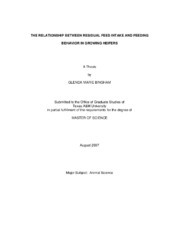| dc.description.abstract | The objective of this study was to determine if feeding behavior traits are
correlated with performance and feed efficiency traits in growing heifers.
Individual dry matter intake (DMI) was measured in Brangus heifers (n = 115)
fed a roughage-based diet (ME = 2.1 Mcal/kg) for 70 d using Calan gate feeders
(6 heifers/pen). Residual feed intake (RFI) was computed as the residuals from
linear regression of DMI on mid-test BW0.75 and average daily gain (ADG).
Heifers with the highest (n = 18) and lowest (n = 18) RFI were identified for
feeding behavior measurements. During days 28 through 56 of the 70-d feeding
trial, continuous video recordings were obtained for all heifers. Video images of
two sets of four 24-h periods, two weeks apart, were analyzed for the focal
animals. All occurrences of feeding were timed and counted per day, and the
eight 24-h periods averaged to derive the overall feeding event (FE) and meal
duration and frequency for each focal heifer. Total feeding event duration was
defined as the total min per day the animal’s head was down in the feed bunk.
A meal included all visits an animal made to the feed bunk that were separated
by less than 5 min. The mean RFI values for the low and high RFI heifers were (mean ± SE) -
1.03 and 1.00 ± 0.03 kg/d, respectively. Low RFI heifers consumed 21.9% less
(P < 0.0001) DMI, but had similar BW and ADG compared to high RFI heifers.
Heifers with low RFI spent more time (P < 0.0001) eating (152 vs 124 ± 4.26
min/d) at a lower eating rate (62.8 vs 99.6 ± 3.28 g/min), but had similar FE
frequencies compared to high RFI heifers. Feeding event duration was
negatively correlated with RFI while FE frequency and FE eating rate were
positively correlated with RFI. However, meal duration and frequency were not
correlated with RFI. Therefore, measuring FE characteristics could prove more
useful than analyzing meals when trying to predict RFI. Additionally, eating rate
appeared to be more closely related to RFI than any of the other feeding
behavior traits measured. | en |


